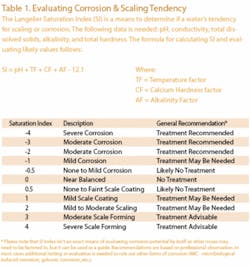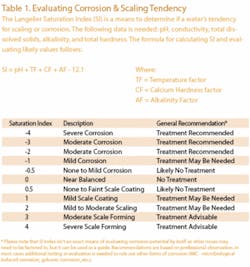Controlling Corrosion and Scaling in Industrial Waters
• The author of the Water Quality Control Handbook discusses controlling pH to minimize corrosion
by E. Roberts Alley, P.E., DAAEE
Most industrial processes that use water often experience corrosion or scaling. Process efficiency is affected by scaling due to lower pipe capacity, and process reliability is affected by corrosion due to pipe failure.
In 1936, W.F. Langlier proposed an index for calculating the Saturation Index (SI) of water using pH, temperature, hardness and alkalinity. A negative SI indicates water with a tendency to corrode and a positive SI a tendency to scale. Temperature and pH, the most influential of these factors, are easily measured on-site. Higher temperatures decrease overall ionic strength increasing scaling. Hardness and alkalinity can be inexpensive to test with hardness equaling the total of calcium and magnesium ions and alkalinity equaling the total of hydroxide, carbonate, and bicarbonate ions.
The tendency to corrode can be eliminated by increasing pH, temperature, hardness, and/or alkalinity. The tendency to scale can be eliminated by decreasing pH, temperature, hardness, and/or alkalinity. Many compounds used in coagulation of wastewater or in pH adjustment will add hardness and/or alkalinity, even with a neutral pH, i.e., lime, soda ash, and caustic. Certain phosphates, such as hexametaphosphate, can be used to sequester or encapsulate calcium and magnesium, reducing scaling.
Once chemical constituents are optimized for corrosion and/or scaling control, the most effective means of control is pH adjustment. Bringing water slightly above its CaCO3 saturation preserves a thin protective coating on the pipe interior to sequester the excess Ca+2 and CO3-2 ions and prevent crystal formation of CaCO3 scale.
Since pH is the negative logarithm of the hydrogen ion concentration in moles/liter, each unit of pH increase has ten times as many hydroxide ions as the lower pH level, and each unit of pH decrease has ten times as many hydrogen ions. At a neutral pH of 7.0 the same number of hydrogen and hydroxide ions must be present.
At very low pH levels, a lot of hydroxide ion (lime or caustic) must be added; but as pH increases, substantially less (by an order of magnitude each pH unit) is added. If hydroxide is added at the same rate for each pH increase, the water will quickly be brought to a very high pH. The opposite is true in the case of lowering pH to prevent scaling. In order to control this logarithmic relationship for corrosion and scaling control, and also prevent overfeeding of chemicals, the following tips are suggested:
- Minimize the size of the pH control basin to limit detention time (e.g., 30 seconds to 5 minutes) preventing short circuiting and decreasing power requirements.
- Provide adequate mixing to assure complete molecular association between the hydrogen and hydroxide ions.
- Consider using two caustic or lime concentrations to raise pH. Use the more concentrated solution for raising pH from 2 to 4 and the less concentrated for raising pH above 4.0. The opposite is true for pH lowering.
- Consider using two or three feed pumps or variable pump rates at the different pH levels. Pumps with variable rates covering several orders of magnitude may be difficult to find.
Following these suggestions to properly balance the water, optimize the hardness and alkalinity chemicals in the water, control water temperature, and adjust pH can eliminate corrosion and scaling in any industrial water situation.
About the Author: Bob Alley is chairman of E. Roberts Alley & Associates Inc., a full service civil and environmental engineering firm based in Nashville, TN. He’s the author of the first and second editions of the Water Quality Control Handbook (a WEF Press book published McGraw-Hill Professional), as well as several other technical articles and books. A Vanderbilt University graduate, he has taught air and water quality control courses at Vanderbilt, George Washington University, the Centre for Management Training and the School for Continuing Engineering Education. Contact: www.eralley.com


